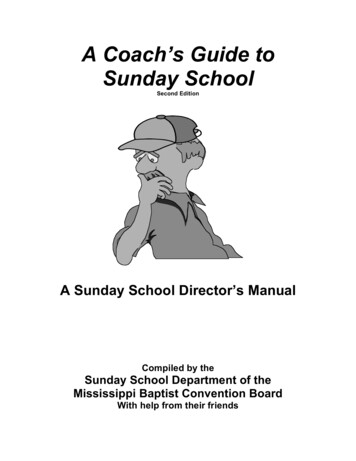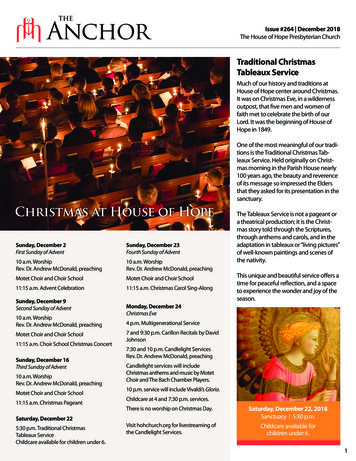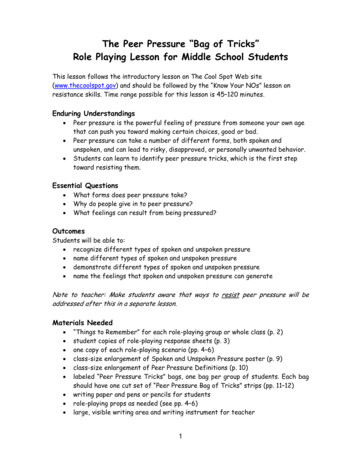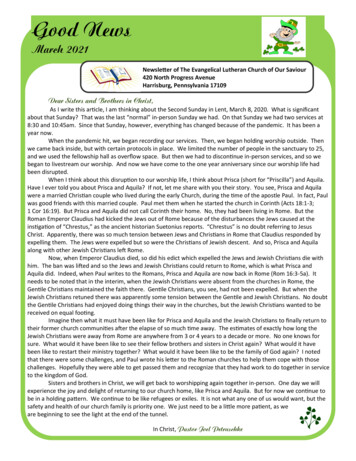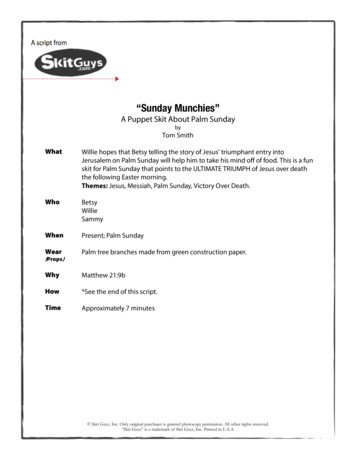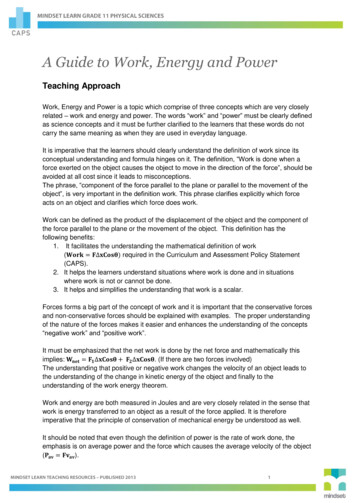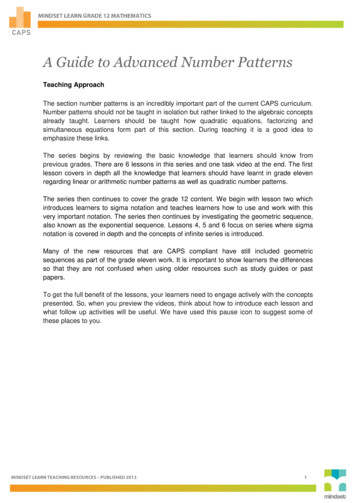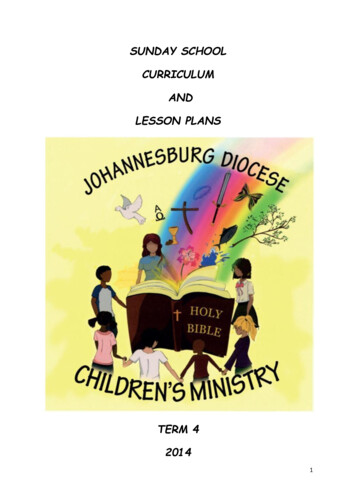
Transcription
SUNDAY SCHOOLCURRICULUMANDLESSON PLANSTERM 420141
INTRODUCTIONTo all Sunday School TeachersThis is the fourth book in our Anglican series of Sunday School lessons. This year we have followedthe readings for Year A in accordance with the lectionary. The New Testament lessons have focusedon the gospel of Matthew and the Old Testament lessons on the books of Genesis and Exodus. Asmentioned before, we are not able to follow the lectionary exactly – the reasons for this are outlinedon pg 3 of this book. We do follow the seasons of the church, which will be apparent in this set oflessons.This term we continue with our study of the Old Testament, specifically the book of Exodus and thestory of Moses. Our focus will then move onto the meaning of Advent and the story of Christmas.We will end the year with a lesson on how much the children have learnt this year.You will notice that many of the lessons for this term have been presented in a very differentmanner. We hope that you and the children enjoy the variety of ideas, but may this also serve as areminder that there are many ways to teach a lesson and you are encouraged to make use of yourown creativity as well as other resources to add to your lesson.Please also note it is not always possible to use all the ideas presented in the lessons of this manual.Sunday Schools do not all have the same amount of time allocated to lessons and so it is importantthat you plan your lesson carefully beforehand, selecting the activities you plan to do and estimatingthe time needed for each part of your lesson.It is also beneficial to start thinking about your lesson a few weeks before you are to teach it - youwill notice that a number of the lessons for this term require materials for crafts that may take a fewweeks to collect, such as egg cartons and shoe boxes - let the children's parents know about thesematerials a few weeks before you need them so they can help with the collection.Should you have any comments pertaining to the content of these lessons, please do contact AliceMuggleston at alice.muggleston@saintthomas.co.za .And as the end of the year draws quickly to an end, do keep in mind the true meaning of Christmas!God bless you all!Dioceses of Johannesburg Children’s ministryAdvent prayerAs we fast approach Christmas,We will be preparing our homes, our gifts and our food.Help us, Lord, to remember to prepare our hearts.Help us in all our busyness,To remember the reason for the seasonHelp us to be like Jesus and bring love, hope and peace to all.Amen2
About this CurriculumWe believe that we have designed a curriculum that is unique to other Sunday school programmes.We aim to provide the children with a firm knowledge of stories from both the New and OldTestaments, while at the same time, observing the Seasons of the Anglican Church and the readingsas set out in the lectionary.As Anglicans, we would very much like to follow the lectionary as closely as possible as it offers arichness to our faith. There are, however, a number of obstacles associated with this when trying todesign a Sunday school Curriculum: The Sunday Lectionary readings do not always follow on from one week to the next hencethe children do not get a sense of the chronological order of events of the Bible.Not all the Bible stories that children should know are covered in the Sunday readings.Stories that come up during the holiday period are never covered.Sometimes two stories that we would like to cover come up in the same week e.g. The Storyof Jacob and Esau and Jesus feeds the five thousand (Year A, 18th Sunday of the Year) , whileother weeks may have readings that are not that applicable to children.This curriculum has been devised to follow all the stories and themes for a year as prescribed in thelectionary, but not necessarily the order of the lectionary. Topics that do correspond with thelectionary reading for the day have been indicated with a *.Each year will begin with stories relating to the life of Jesus, miracles and parables. We will thenmove into Lent with topics relating to a special Lenten theme. After Easter the topics chosen for thesecond term will relate to going out into the world to live a life for Jesus. The third and fourth termwill focus on the Old Testament stories.The section from the Old Testament that the lectionary focuses on for a particular year will becovered: Year A: The Creation through to MosesYear B: Joshua through to SamsonYear C: The Prophets.The last few lessons of each year are devoted to Advent and Christmas.3
How to prepare for a lessonPray for yourself, the children in your group and the lesson message.Read the Bible to learn and understand the story and the spiritual truths. Study related Biblepassages and other translations of the Scriptures.Enrich your background understanding. Read the information for the teacher found at thebeginning of each of our lessons in this manual. If you are able to, look at reference books, consultan atlas etc.Prepare. Preferably, you should be thinking about your lesson a week before you are due to give it,so that you are able to collect the materials you need over that week. Decide how you will presentthe material and what activities you will do. Prepare the teaching aids and anything else needed forthe lesson. It is important to plan a lesson which is not too short or too long. It is good to have afew extra activities planned should the church be running late.Here follows a basic lesson structure you can use, although not all components are necessary everylesson: WelcomeIntroduction to the theme and attention grabberBible readingPrayerMemory verseCraftSongPhysical activityWorksheetSnackAim of the lesson. Know what you wish to accomplish during the lesson.Reach the children. Choose the best methods to convey the message to the children. Use an ageappropriate Bible. Remember that children learn best by actively doing things and exploring anddiscovering for themselves. Try to vary your activities from week to week e.g. try artwork activitiesthat include painting and collage to encourage creativity.Evaluate the lesson after teaching it. Ask yourself questions such as: What went really well?What did the children enjoy?What will I do the same next time and what will I do differently?(The PREPARE idea is inspired by The South African Sunday School Association)4
CurriculumTerm 4 2014The OldTestament:Moses1DateWeek in ChurchyearLesson19 OctoberTwenty-ninthSunday of theyearThirtieth Sundayof the yearThirty-firstSunday of theyearThirty secondSunday of theyearGod to the rescue226 October32 Nov4Advent12ChristmasHow much doyou know?9 Nov16 Nov23 Nov30 Nov7 DecThirty thirdSunday of theyearThirty fourthSunday of theyearFirst week ofAdventSecond week ofAdventPage6Let my people go!22Free at Last37A desertAdventureBe prepared(The parable ofthe 10Bridesmaids)His name is John(John the Baptist)Jesus, the gift ofChristmasHow much do youknow?5165728096Gauteng School Term: 13 October – 10 Dec 20145
Moses: God to the rescue!Twenty-ninth Sunday of the yearBetween 16 and 22 OctoberReadings: Exodus 1 - 4Theme: God has a planMemory verses: “Trust in the Lord with all your heart and lean not on your own understanding”Proverbs 3:5Information for the teacher:The story of Moses is found in the book of Exodus and follows on from the story of Joseph and his family inEgypt. Joseph’s father Jacob and his family moved to Egypt from Canaan to avoid the 7-year famine. They livedin Goshen, a very fertile land in Egypt as successful shepherds and breeders of livestock. Jacob died at 132 yearsand he was buried back in his home town of Canaan in his ancestral tomb.Some 400 years later, after the death of Joseph and all of his generation, things had changed dramatically forthe Israelites (the name given to the descendants of Jacob, who was renamed Israel by God during a strugglewith an angel during his journey back home to his brother Esau. Gen 32:28). The new Pharaoh and the otherEgyptians became worried that there were too many Israelites and felt that if a war were to break out, theymay join with the enemies to defeat the Egyptians. So, a decision was made to make them slaves of theEgyptians, forcing them to work in fields and do very hard manual labour. But the more the Israelites weretreated badly the more they multiplied and spread. The King then ordered the Egyptian midwives to kill all ofthe Israelite males at birth, an order which they disobeyed and so their numbers continued to increase. Thismade the Pharaoh furious and thus he decreed that every Israelite boy child be thrown into the river Nile.Through all this suffering, God heard the cries of His people – He had a plan to free His people from slavery, andthis is where our lessons begin – the story of Moses.The lessons for the next 4 weeks will follow the story of Moses. For the younger ones, today’s lesson will focuson Moses, the baby in the basket. Since the older children should be familiar with the story of Moses as a baby,today’s lesson will primarily deal with Moses’ encounter with God in the Burning Bush.The next few weeks will tell the story of Moses’ encounter with God - the burning bush, the Ten Plagues, theExodus from Egypt, the parting of the Red Sea, the Israelites’ time in the desert and finally, their entry intoCanaan, the Promised Land.In order to remind the children of what has been done each week in the lessons on Moses, a suggestion is tocreate a Moses corner in the room where your Sunday School is held. A doll in a basket can represent Moses inthe bulrushes; a small tree surrounded by sand can represent the burning bush etc. Another suggestion is toplace samples of each week’s activities on a table. Each week, your lesson could begin around this collage ofthings where children recall the story so far. A map to follow the events of each week can be stuck onto thewall.It would be beneficial to remind yourself of the story of Joseph learnt last term as well as to familiarise yourselfwith the whole story of Moses before beginning this series of lessons. Reading the story from a Children’s Biblecan give a good overview.6
Lesson Suggestions:Younger Children (3 – 6 year olds)Lesson Objectives: To teach children the story of Baby Moses and how he was saved To remind the children that God cares for usAttention Grabber:Who has baby Moses? The children sit in a circle close together. The child who is “it” stands awayfrom the circle and looks away while baby Moses is passed around. (Baby Moses needs to besomething small like a tiny figure – even a clothes peg can represent baby Moses). When “it” says“stop”, the child holding baby Moses hides it e.g. under a leg or up a sleeve etc. The child who is “it”now guesses who has baby Moses. The child who had Baby Moses then becomes “it” and the gameis repeated.Setting the scene:Materials needed:Doll/play dough figure of Moses; a small cloth to represent a blanket to wrap baby Moses; a smallbasket or container that can be used as a basket for baby Moses; 4 female play dough figures or 4dolls, one of whom has a crown; a long piece of blue fabric or crepe paper to represent the riverNile; some “veld” grass, perhaps put in bottles to represent the reeds along the river.Ask the children to sit in a circle with you at the head. Spread out the blue fabric or paper torepresent the river Nile. Put some tall grass along one end of the river. Place the dolls and othermaterials next to you. Now, begin to tell the story.Bible Story (Ex 1 and 2:1- 10) – Moses in the bulrushesBegin: “I’m going to tell you a story about a little baby named Moses. This story is found in thesecond book of the Bible called Exodus. Can you remember the name of the first book of the Bible?(Give the children time to respond).Moses had an older brother named Aaron and an older sister, Miriam. His family lived in a countrycalled Egypt but their home town was very far away in another place Canaan. So, what were theydoing in Egypt? Listen and you will find out!A long, long, very long time before, Moses’ ancestors (Moses’ great – great- great –great .grandparents)didn’t have enough food in their hometown of Canaan so they had to travel all theway to Egypt to find food.(Perhaps use a map to trace the journey of Joseph’s family from Canaan to Egypt- one is at the endof the lesson)7
Luckily for them, one family member, Joseph was already living there and had a very important job.They were treated very well so they decided to stay. (You may want to ask them if they rememberthe story of Joseph but if you think it will distract them, don’t!)But things started to change just before Moses was born. Pharaoh – the King, and the people ofEgypt became worried because there were a lot of Israelite people and they felt that if there was awar, the Israelites would join with the enemy (the people who didn’t like them) and kill theEgyptians. So, the King who was very mean decided to make them slaves, which means they weregiven very hard jobs to do like building cities and they had to work all day. And, if that wasn’t badenough, he came up with a plan that all the Israelite baby boys must be killed. God was of course nothappy with the way that His people were being treated – He needed a plan to rescue His people.Now this is where our story really begins Baby Moses was one of those babies that Pharaoh wanted killed. However, Moses’ mother came upwith a plan of her own. She was going to hide her baby. Do you think that it would be easy to hide ababy? (Give the children a chance to speak)Of course, many families also tried to hide their babies. But after 3 months, as Moses grew bigger, itwas much more difficult to hide him as he was very noisy and would cry loudly.In the end, his mother took a basket and covered it with a black paste called tar so that watercouldn’t get in, and she gently laid her baby in it. She then took the basket down to the River Nileand placed it among the tall, thick grass near the edge of the water so it won’t float away. Miriam,Moses’ big sister was to look after baby Moses, to watch that nobody found him.(At this stage, take up the Moses figure, wrap it in the small cloth and place him in the basket. Putthe basket among the grass, then take one of the dolls representing Miriam, his sister and put hera little way off in the grass.)Song: Have the children sing, Where is Moses? (Tune: Where is Thumb kin?)Where is Moses, where is MosesThere he is, there he is! (pointing)He is in the river, right among the tall grassAmen! Amen!(For the slightly older children you may like to try one group singing the 1st line and the other the 2nd.You will probably need another teacher to help you with this)Continue: A little while afterwards, a young princess and some of her servants came walking alongthe bank of the river as they were coming for a little swim.(Have 3 children take the remaining dolls and move them along the end of the river with thePrincess in front)At the same time, Miriam was becoming nervous. What was she going to do?(Start to bite you fingers and have the children do the same as if they are worried)It was at that time that the Princess saw the basket and sent one of her servants to fetch it. As soonas the Princess saw the baby she realised he must be an Israelite boy. As she lifted him up he beganto cry!8
(Have the children pretend to be crying).She felt sad for this poor little baby and decided to take him home and keep him.Brave Miriam (coming out of hiding and approaching the princess) went up to the Princess andasked, “Would you like me to find a nurse for the baby, your Highness?”“Yes, that would be lovely”, replied the Princess. Miriam then ran home to fetch her mother to bethe nurse. The princess said to the baby’s mother, “Take this baby and look after him for me until heis older”Song: Rock-a-bye-Moses (Tune of “Rock-a-Bye Baby”)Rock-a-bye Moses in your small boat (Rock pretend baby – Cup hands like a boat.)Made by your mother so it would float (Make wave motions with hands)God planned you special, a baby dear—- (Point up)Rocking and sleeping without any fear (Rest head on hands.)Continue: When the child grew older, his mother took him to the princess, and he became her son.So, the little baby grew up like a little Egyptian Prince in the palace of the King. The Princess lovedhim so much that she decided to call him Moses, which means “saved from the waters”.(Now, this is only the beginning of the story of Moses! It gets more exciting as God had great plansfor Moses as he gave him a big and important job to do – to save God’s people from slavery)Discussion: Ask the children if they liked the story and to give their favourite part of the story. (Allowthe children time to respond and express their ideas freely without interrupting)Who were the people in the story?Who is your favourite person in the story?Who found Moses?Who took care of the baby?What does the name Moses mean? Craft:Make a collage of baby Moses in the bulrushes.Materials needed: strips of blue paper to represent water; either grass or strips of greenpaper for the reeds; a picture of a basket with a baby in it; 3 pictures of girls – pictures canbe found at the end of this lessonThe children can stick the materials onto an A4 card or paper. Colour in a picture of baby Moses in the bulrushes – a picture can be found at the end of thelesson.9
Snack: Make the scene of baby Moses in the bulrushes using snacks! Here is an example:On a paper plate, use blue jelly* to represent the river; green icing on either side of theriver with brown pretzel sticks stuck up to represent the reeds; a small ice-cream cone cupto represent the basket and a jelly baby to represent baby Moses. (*Blue jelly cansometimes be found in the shops, else add blue food colouring and sugar to gelatine)Song:God is so goodGod is so good, God is so good, God is so good. He’s so good to me.He saved my soul. He saved my soul. He saved my soul. He’s so good to me.I love him so. I love him so. I love him so. He’s so good to me.Prayer: Dear Lord we thank you that just as you cared for your people in Egypt, you also loveus and care for us. Bless our families and those who care for us and keep us safe. Amen.NB! Ask the children (or their parents) to bring empty egg cartons and shoe boxes toSunday School over the next few weeks. The egg cartons will be used in the lesson onMoses in 2 weeks time and the shoe boxes will be used for the Christmas lesson.Older children (7 to 13 years)Lesson Objectives: To revise the story of the early life of Moses To teach the children about Moses’ encounter with God through the burning bush. To learn to trust in God and not lean on our own understandingAttention Grabber:(There are 2 different concepts in the discussion which follows. Choose one concept so as to notspend too much time on this part of the lesson) Do you think you could move to another country and leave everything including your familybehind if God asked you to?Who in the Bible had to move/relocate leaving almost everything behind and why?(Abraham when God asked him to move from Ur to the land of Canaan; Joseph, who wassold into slavery and taken to Egypt)or What are some of the traditional ways people communicated with each other: (smokesignals; drums; vuvuzela; telegram, Homing pigeons have been used in war times to sendand bring information. smoke signal is one of the oldest forms of long distancecommunication used to transmit news or alert people to danger)How do we communicate with each other now? (letters, email, telephone, skype)10
Do you think God communicates with us using any of the ways mentioned above?What are some of the ways God communicates with God’s people? (Through symbols suchas the Dove – Jesus’ baptism; Cloud – Ascension; Flames of Fire, Dove – Pentecost; throughthe Prophets- messengers of God; voice – as with the story of Samuel)In today’s lesson we will learn about a man called Moses – it is a familiar story so you might haveheard it before. We will learn how God spoke to him and the plan that God had for him – a planwhich was very different to Moses’ plan for his life. As you listen to the story today think how youwould have reacted.Setting the scene:Make use of the information for the teacher at the beginning of this lesson to set the scene,briefly reminding the children of the story of Joseph and how the Israelites came to live in Egypt.A map is provided at the end of the lesson to trace the journey of Joseph’s family from Canaanto Egypt.Explain how God’s chosen people were now called Israelites.Continue by discussing how things changed when the Pharaoh became worried that there weretoo many Israelites, and that a decision was made to make the Israelites slaves of the Egyptians.He further decreed that every Israelite boy was to be thrown into the River Nile.Explain that God heard the cries of His people – He remembered His covenant or agreementwith their ancestors, Abraham, Isaac and Jacob.He had a plan to free His people from slavery and this is our story for the next few weeks – thestory of Moses.Continue by telling them that today’s story is taken from the second book of the Bible, Exoduswhere we learn about Moses, a little Israelite boy who grew up in an Egyptian palace.Since the birth of Moses is a familiar story, ask for volunteers to recap the story about Moses asa baby. Refer to Exodus 2: 1 – 10.Also, briefly discuss that when Moses was a young man, he had to flee from Egypt – why?Moses did not like it that the Israelites, his own people, were being treated as slaves. One day,he saw an Egyptian assaulting an Israelite. He became so angry that he killed the Egyptian. Hethen fled to Midian (Ex 2:11-15)After much wandering, he came to a well, where he protected a young girl and her sister fromsome shepherds who were bullying them. He later married the young girl, Zipporah.Today our lesson will focus on the story of the burning bush – when God called Moses to cometo the aid of the Israelites.11
Bible Story - (Ex 3 and 4) - The burning bushThe following skit can be used instead of reading the story from the Bible. It would be very beneficialif the children presenting this skit have a few minutes to practice before performing it to the class –the better presented, the more impact this skit will have. The person chosen to perform the role ofMoses needs to provide actions following the words ofthe script.SKIT(Print the script and distribute)Setting: Church gardens. (Find a bush and do the lesson in front of the bush)Characters: Narrator; Moses; GodProps: A staff for Moses, made out of pipe cleaner or something that can bendStart the story a little way from the bush.Narrator: One day, Moses was taking care of a flock of sheep, belonging to Jethro, his father-in-law.He led the flock to the west side of the wilderness and came to Horeb, also called Mount Sinai, themountain of God when he saw a strange sight. There was a bush on fire but even though there wereflames, it didn’t burn.Moses: Hmm! Very strange. Let me go closer and see what’s happening. (Start walking towards thebush). I wonder why the bush is not burning up.Narrator: As he drew nearer, he heard a voice coming from the flames.God’s Voice: Moses, Moses!Moses: Here I am.God’s Voice: Do not come near - remove the sandals from your feet, for the place on which you arestanding is holy ground. (Moses takes off his shoes)God’s Voice: I am the God of your father, the God of Abraham, the God of Isaac, and the God ofJacob.Narrator: Then Moses hid his face, for he was afraid to look at God. (Moses turns away)God’s Voice: I have been observing the hardships of my people who are in Egypt, and I am aware oftheir suffering. So I have come down to deliver them from the power of the Egyptians. So Moses, Iam sending you to Pharaoh, so that you may bring my people, out of Egypt.12
Moses: Me! Why me? Who am I to go to Pharaoh, and that I should bring the sons of Israel out ofEgypt?God’s Voice: Do not be afraid, Moses! I will be with you.Moses: And, what must I say to them? They won’t believe me?God’s Voice: This is what you will say to the Israelites, ‘I AM has sent me to you. The Lord, the God ofyour fathers, the God of Abraham, the God of Isaac, and the God of Jacob, has sent me to you.” Hewill deliver you out of your misery in Egypt and take you into the land of Canaan, a land flowing withmilk and honey!Moses, don’t worry! The elders will listen to you. Then you with the elders of Israel must go to theking of Egypt and say to him, ‘The Lord, the God of the Hebrews, has met with us. So now, please, letus go on a three days’ journey into the wilderness, to make a sacrifice to the Lord our God.’But I know that the king of Egypt will not allow this. So I will stretch out my hand and strike Egyptwith all my miracles and after that he will let you go.Moses: But what if they do not believe me or listen to what I have to say?God’s voice: Is that a staff in your hand? Then throw it down. (Before throwing it down, twist thestaff to make a snake)Moses: A Snake!! (Moses runs off)God’s voice: Pick it up by the tail. (Moses, looking scared, picks it up, and straightens it into a staff)Narrator: As Moses picked up the snake it turned back into a staff. The Lord performed many moremiracles. He asked Moses to put his hand inside his cloak. When he took it out, it was white as if hewas suffering from leprosy. He then asked him to put his hand again in his cloak and when he took itout it was normal. The Lord continued by showing him another sign just in case the Pharaoh did notbelieve the first two signs. He told him to take a cup of water from the river Nile and to pour it ondry ground. The water will then turn to blood when it touches the ground.Moses: But, but I’m not good at speaking. I talk very slowly.God’s voice (sounding a bit angry): Who gave man his mouth? Is it not I? Then I will help you tospeak and will teach you what to say.Narrator: Moses was still not convinced and he begged God to send someone else. So Godsuggested that his brother Aaron, who was good at speaking, would do all the talking, and Moseswould perform the miraculous signs.Then Moses went back to Jethro his father-in-law and told him about his mission from God.13
Discussion and Questions: (Please note there are many questions – it may beoverwhelming to do all of them. Select questions which you think are best suited to theneeds of your class) What is your favourite part of the story and why? Do you sometimes feel as Moses did, like you’re not able to do some of the things beingasked of you? How can you overcome these feelings?Fact Questions Before the story about the burning bush, we learn that Moses had to run away from Egypt.Why? (He had killed an Egyptian and he was scared) Name the place that Moses fled to? (Midian) Where did he meet the girls? (At a well ) Which one did he marry? (Zipporah) What was the name of his father-in -law? (Jethro) Name the mountain where Moses saw the Burning Bush? (Mount Horeb / Mount Sinai) Why did God instruct Moses to take off his shoes ?(The ground Moses was standing on washoly ground, for God was present) What was God’s plan for Moses? (To lead God’s people out of slavery) What miracles did God show Moses for him to demonstrate to the Israelites as well as thePharaoh that God was with him? (When Moses placed his hand into his cloak, it came outwith leprosy and then when he put it back into his cloak, it came back normal; Moses staffchanged into a snake) Why did Moses think he was not fit for the task being given to him? (He wasn’t good atspeaking. Perhaps he lacked confidence) Who did God send with Moses to help him lead the people out of Egypt? (Moses’ brother,Aaron)Emotion questions What feelings do you think caused Moses to go closer to the burning bush? (wonder,curiosity)What feelings do you think prompted Moses to give excuses? (fear)What did Moses do that made God angry? (Asked not to be sent back to Egypt; madeexcuses for not doing what God asked of him)14
Application Questions How do we accomplish tasks that we think are too hard for us to do? (We trust in God toprovide everything we need) So, what can we learn from this story?(Let the children come up with their own suggestions –each child may have a differentresponse to the lesson and there is no correct answer – some suggestions are: God equips us;God is with us; Trust in God.God can use each one of us. We only need to listen for him and to do what he needs us to do.We may not hear the words of God coming out of a burning bush the way Moses did, but wecan hear the voice inside us that helps guide us to do what we are supposed to do)Snack: Sour worms to represent Moses’ staff that changed into a snake, or any red, yellowand orange snacks to represent the burning bush e.g. oros, nik-nak chipsWorksheet: Activities can be found at the end of the lesson. To make the coded wordworksheet harder, you can remove the answers at the bottom of the page. Craft:Each child can create their own response to the lesson – what in the lesson stood out mostfor each child?An outline for a pyramid can be found at the end of the lesson, which the children canconstruct to remind them of the Israelite’s time in Egypt.Prayer: Dear Lord, we know that with you all things are possible. Help us to lean not on ourown understanding but to trust you with all our heart. Help us to find our true purpose in life andnot to run away and doubt, but to have faith. AmenReferences:1. http://www.bing.com/images/search?q map from canaan to egypt&qs n&form QBIR&pq map from canaan to egypt&sc 0-12&sp 1&sk #view detail&id ndex 92. http://www.pic2fly.com/3D Cut out Pyramid Pattern.html3. oses-sunday-school-lessons.html4. 1d211ade01df.wix mp 5125
ead the Bible to learn and understand the story and the spiritual truths. Study related Bible passages and other translations of the Scriptures. E nrich your background understanding. Read the information for the teacher found at the beginning of each of our lessons in this manual. If you a

